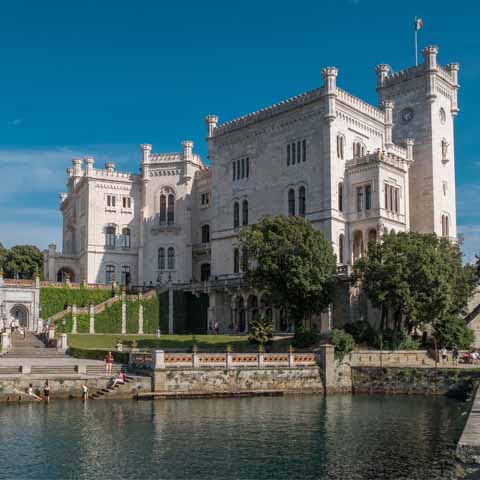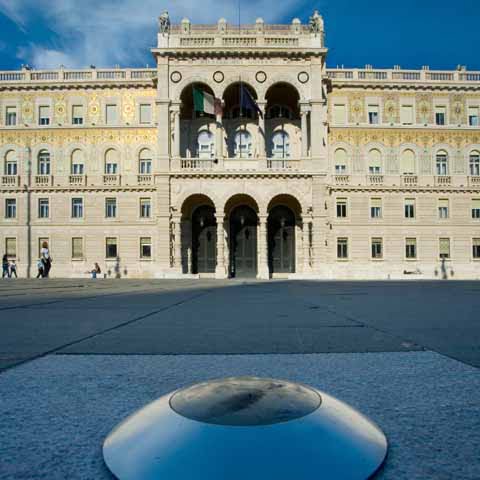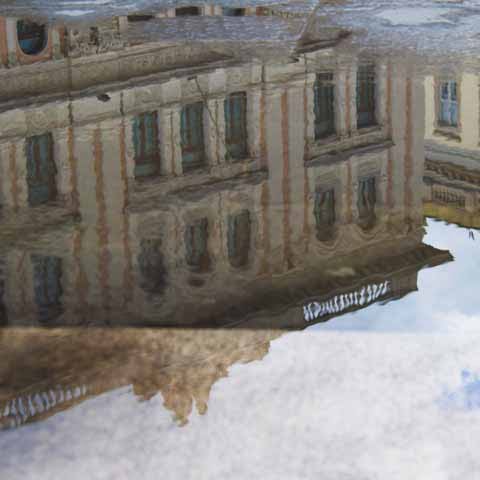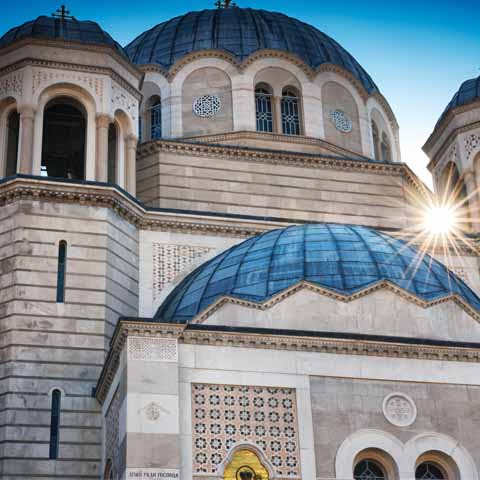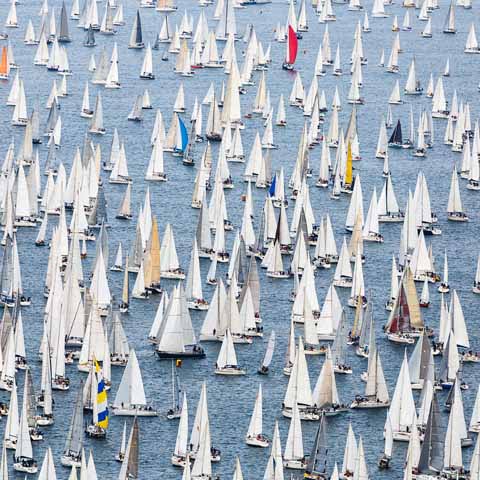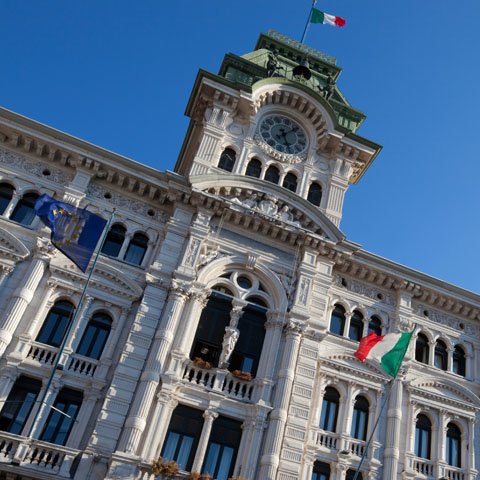The city and seaport of beautiful Trieste is located in the northeastern part of Italy in the region of Friuli Venezia Giulia. Because of its location on the Gulf of Trieste and Adriatic Sea, its proximity to Slovenia, and Austrian influences, the city is a wonderful melting pot with people from all walks of life. These influences have combined to fill the city with amazing original culture in the form of breathtaking architecture, literature, music, and more.
ARCHITECTURE IN TRIESTE
One of the defining examples of architecture in the city is Piazza dell’Unità d’Italia. The square is home to a handful of gorgeous, stately buildings that border the square on three sides before it opens up to a picturesque view of the Gulf of Trieste on the fourth.
It is considered to be one of the largest European seaside piazze. The city hall is one of the more impressive buildings that stands tall over the piazza due to the Fountain of Four Continents that sits in the front courtyard. The Palazzo del Governo is another government building in the square with a stunning balcony made from mosaics and glass. Other structures of note here in the piazza are Palazzo del Lloyd Triestino and Palazzo Stratti.
The Cathedral of San Giusto, also called the Trieste Cathedral, was established circa the fourteenth century after two pre-existing buildings were merged together and renovated to create it. The exterior of the building is a combination of neutral and ivory brick stones that beautifully complement an intricately designed rose window that sits adjacent to a singular, small bell tower. The interior of the church features a series of columns and archways with one nave and four aisles. Beautiful mosaics and colorful frescoes can be admired throughout the church.
Not far from the Trieste Cathedral is the Castle of Saint Giusto, a fortress and museum. The castle, which was built centuries ago did not experience significant military activity, which left the building in excellent condition. Still today it is possible for visitors to climb the tower and take in the one of a kind panoramic views of the Gulf of Trieste and the Adriatic Sea. The museum is located inside the castle and offers multiple artifact exhibits as well as a detailed history of the castle over the centuries.
Just north of Trieste, travelers can visit the famous Miramare Castle. Located along the coast of the Gulf of Trieste, the nineteenth century castle was constructed for Austrian Archduke Ferdinand Maximilian. The extensive castle features opulent rooms with stunning artwork and period furniture. The beautiful grounds surrounding the castle are well-cared for and feature various species of trees and plants.
Also on the shore of the Adriatic Sea is the Faro della Vittoria, translated as Lighthouse of Victory. The lighthouse sits on the Gretta Hill and still serves ocean vessels navigating the Gulf of Trieste. It is a monument to those who lost their lives in World War I and is one of the tallest lighthouses in the world, standing at just over two hundred feet tall.
Trieste also has an older lighthouse, called Lanterna, that is no longer in use. Designed by the Austrians, it is believed that the Lanterna stands on a site that has been used for maritime signals since the time of the Ancient Romans. This lighthouse reaches a height of 102 feet and features a stone tower that extends from a circular base.
ART IN TRIESTE
The city of Trieste is home to over 30 museums, many of which trace the local artistic heritage. Among these is the Revoltella Museum. Founded in the nineteenth century, the museum serves as a modern art gallery with a focus on nineteenth and twentieth century art. Artists represented at the museum include locals such as Alice Psacaropulo and Arturo Rietti, as well as nationally important artists such as Lucio Fontana, Giorgio De Chirico, and Giovanni Fattori.
With a location right off the Gulf of Trieste and the Adriatic Sea, the city has a long seafaring history. Although the Gulf of Trieste has witnessed many military conflicts over the centuries, the city has maintained its presence as a crucial naval and commercial shipping port. The Museo del Mare thoroughly traces this ancient seafaring background and provides an overview of the port’s history. Exhibits can include painstakingly detailed model ships and cross sections of various vessels as well as equipment and artifacts salvaged from historical ships.
LITERATURE
Trieste has long been considered to be a utopia for writers. The quaint and luxurious cafés that look out to the Adriatic Sea allow for deep contemplation over some of the best coffee in all of Italy. The atmosphere is so inspirational, it has been known to attract aspiring writers for that sole purpose.
Historically, the allure of Trieste has impacted writers such as James Joyce, Italo Svevo, Sir Richard Francis Burton, Umberto Saba, and Jan Morris.
Italian author Aron Ettore Schmitz, more commonly known as Italo Svevo, was born in Trieste in the late nineteenth century. He became a popular play writer and businessman. Written in Trieste, his famous work La Coscienza di Zeno ( Zeno’s Conscience), is thought to have had a substantial effect on the modernist movement. Today Svevo is considered to be the father of the Italian psychological novel.
Umberto Saba is another Italian author born in Trieste in the late nineteenth century. Although his heart belonged to poetry, he was the owner of an antique bookstore in Trieste for a time. Saba is probably best known for his poetry collection, Il Canzoniere, a collection of more than four hundred poems that features three volumes published over multiple decades. Saba’s poetic style was considered to be in opposition to the prevailing style of the twentieth century, as the poet adopted nineteenth century metrics as well as elements of ancient poetry. Although the writer is thought to have struggled for much of his life with depression, he created beautiful poetry that is still read and studied today.
Irish author James Joyce spent almost a decade living in Trieste where he was inspired to write Portrait of the Artist as a Young Man and Dubliners. He spent a good deal of time in cafés along the Gulf of Trieste in the early twentieth century and became so enamored with the area he is honored with a personalized plaque at one of the cafés with a quote from Joyce that reads, “I came here habitually.”
Jan Morris, a twentieth century historical writer, wrote a portrait of Trieste and categorized it as the ultimate “nowhere-place” and that “melancholy is Trieste’s chief rapture. In almost everything I read about this city by writers down the centuries, melancholy is invoked.”
It is said that historically, some thought the atmosphere of Trieste to be sad, or, as Morris suggests, melancholy. Perhaps the tight quarters amongst buildings and the boat traffic in the port made it feel more businesslike than enjoyable. That said, today Trieste welcomes tourists from across the globe, many of which are repeat visitors that come to revel in the beauty of this thriving port city.
There are several museums in the city dedicated to Trieste’s past as a literary center. Among these is the Joyce Museum that displays works that the Irish writer completed during his time in Trieste, plus a library with a complete collection of his works. The Svevo Museum, on the other hand, chronicles the life and work of Italo Svevo with autographed manuscripts, letters by the author, and editions of Svevo’s works with handwritten notes.
Also of note is the Petrarca and Piccolomini Museum, which contains manuscripts and historic volumes of works by fourteenth century Italian writer Petrarch and former Bishop of Trieste Enea Silvio Piccolomini, also known as Pope Pius II. The museum is home to the most complete collection of Petrarch’s works in Italy.
MUSIC
Trieste is home to one of the most popular and luxurious theaters in Italy. Teatro Verdi is a gorgeous opera house named after the renowned Italian opera composer, Giuseppe Verdi. The theater is regularly home to symphony concerts, musical performances, and even ballet. The exterior of the theater exhibits Austrian influences, and the interior is stunning and extremely ornate, with a gilded interior of several floors, balcony seats, and lavish chandeliers.
The Giuseppe Tartini Music Conservatory can also be found in Trieste. The conservatory is named after composer and violinist Giuseppe Tartini and is home to the internationally renowned Trieste Trio chamber music ensemble.
CINEMA
Since the mid to late twentieth century, movie producers have been increasingly drawn to the city. With its maze of buildings, winding streets, and narrow roads that all overlook the blue expanse of the Adriatic Sea, Trieste has become particularly popular amongst Italian movie producers and is gaining international recognition.
Films set in Trieste over the decades include: Alfa Tau! (1942), Sleeping Car to Trieste (1948), Trieste Mia! (1951), Ombre su Trieste (1952), Diplomatic Courier (1952), Senilità (1962), The Yellow Rolls-Royce (1964), La ragazza di Trieste (1982), Giulia e Giulia (1987), Il ragazzo invisibile (2014), Isabelle (2018), Non odiare (2020), and Tolo Tolo (2020).
SCIENCE
Each September, Trieste hosts Trieste Next, an event dedicated to scientific research. Organized by the University of Trieste, the event attracts researchers from all over the world to present and share their work.
Historically, Trieste was also the birthplace of several important scientists including chemist Guido Goldschmiedt, astronomer Spiridon Gopčević, chemist Giacomo Ciamician, mathematician Salvatore Pincherle, and physicist Lavo Čermelj,
Travel the city to take in the original culture of Trieste, and then grab a table at a seaside café to sip on some of the finest coffee in Italy as you contemplate the simple beauty that visitors find in the city and the internal peace it creates for beholders.
Don't just see Italy, live it.
Your dream trip to Italy has never been closer
No more endlessly scrolling travel sites. Our travel experts will craft the perfect, one-of-a-kind trip just for you.

300+
DESTINATIONS
We offer more Italian destinations than any travel site. Do and see more with Trips 2 Italy.
1 (of a kind)
ITINERARIES
Because your dream trip to Italy should be designed for you, not for the masses.
100%
PEACE OF MIND
From flights and accommodations, to food and activities - we take care of every detail.
